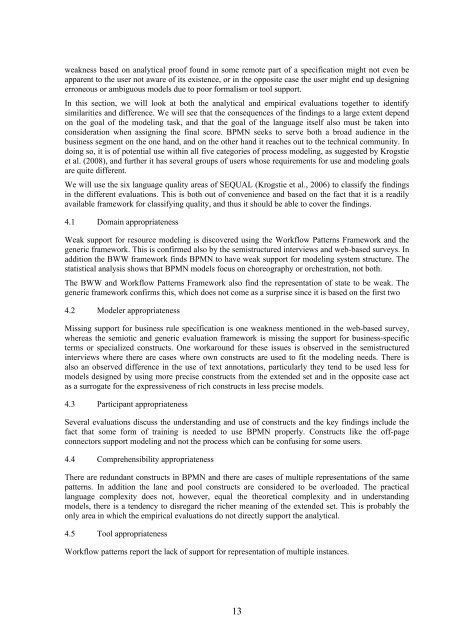Multi-channel provisioning of public services - Department of ...
Multi-channel provisioning of public services - Department of ...
Multi-channel provisioning of public services - Department of ...
You also want an ePaper? Increase the reach of your titles
YUMPU automatically turns print PDFs into web optimized ePapers that Google loves.
weakness based on analytical pro<strong>of</strong> found in some remote part <strong>of</strong> a specification might not even be<br />
apparent to the user not aware <strong>of</strong> its existence, or in the opposite case the user might end up designing<br />
erroneous or ambiguous models due to poor formalism or tool support.<br />
In this section, we will look at both the analytical and empirical evaluations together to identify<br />
similarities and difference. We will see that the consequences <strong>of</strong> the findings to a large extent depend<br />
on the goal <strong>of</strong> the modeling task, and that the goal <strong>of</strong> the language itself also must be taken into<br />
consideration when assigning the final score. BPMN seeks to serve both a broad audience in the<br />
business segment on the one hand, and on the other hand it reaches out to the technical community. In<br />
doing so, it is <strong>of</strong> potential use within all five categories <strong>of</strong> process modeling, as suggested by Krogstie<br />
et al. (2008), and further it has several groups <strong>of</strong> users whose requirements for use and modeling goals<br />
are quite different.<br />
We will use the six language quality areas <strong>of</strong> SEQUAL (Krogstie et al., 2006) to classify the findings<br />
in the different evaluations. This is both out <strong>of</strong> convenience and based on the fact that it is a readily<br />
available framework for classifying quality, and thus it should be able to cover the findings.<br />
4.1 Domain appropriateness<br />
Weak support for resource modeling is discovered using the Workflow Patterns Framework and the<br />
generic framework. This is confirmed also by the semistructured interviews and web-based surveys. In<br />
addition the BWW framework finds BPMN to have weak support for modeling system structure. The<br />
statistical analysis shows that BPMN models focus on choreography or orchestration, not both.<br />
The BWW and Workflow Patterns Framework also find the representation <strong>of</strong> state to be weak. The<br />
generic framework confirms this, which does not come as a surprise since it is based on the first two<br />
4.2 Modeler appropriateness<br />
Missing support for business rule specification is one weakness mentioned in the web-based survey,<br />
whereas the semiotic and generic evaluation framework is missing the support for business-specific<br />
terms or specialized constructs. One workaround for these issues is observed in the semistructured<br />
interviews where there are cases where own constructs are used to fit the modeling needs. There is<br />
also an observed difference in the use <strong>of</strong> text annotations, particularly they tend to be used less for<br />
models designed by using more precise constructs from the extended set and in the opposite case act<br />
as a surrogate for the expressiveness <strong>of</strong> rich constructs in less precise models.<br />
4.3 Participant appropriateness<br />
Several evaluations discuss the understanding and use <strong>of</strong> constructs and the key findings include the<br />
fact that some form <strong>of</strong> training is needed to use BPMN properly. Constructs like the <strong>of</strong>f-page<br />
connectors support modeling and not the process which can be confusing for some users.<br />
4.4 Comprehensibility appropriateness<br />
There are redundant constructs in BPMN and there are cases <strong>of</strong> multiple representations <strong>of</strong> the same<br />
patterns. In addition the lane and pool constructs are considered to be overloaded. The practical<br />
language complexity does not, however, equal the theoretical complexity and in understanding<br />
models, there is a tendency to disregard the richer meaning <strong>of</strong> the extended set. This is probably the<br />
only area in which the empirical evaluations do not directly support the analytical.<br />
4.5 Tool appropriateness<br />
Workflow patterns report the lack <strong>of</strong> support for representation <strong>of</strong> multiple instances.<br />
13
















